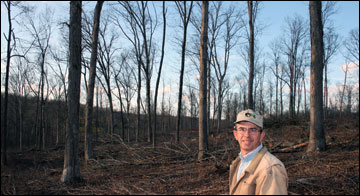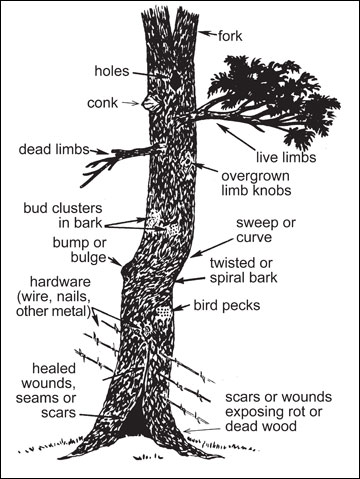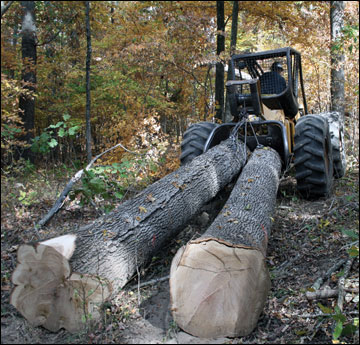
Hank Stelzer
Forestry State Specialist
School of Natural Resources

Many landowners receive only a fraction of their timber's true value because they do not know what they have or how to sell it. Selling timber can be a rewarding experience if you understand the steps involved. This guide will not make you an expert, but it will explain the basic steps involved in selling timber, so you can feel more comfortable during the process and better about the results of your sale (Figure 1).
The first step in conducting a timber sale is to select a professional forester. Many landowners often ask why they should have a forester help them sell their timber. The answer is quite simple: Like your financial planner who helps ensure your retirement and estate goals will be met and your family doctor who prescribes the proper care to ensure your long-term health, a professional forester helps ensure your timber sale will be financially and ecologically successful.
If you cannot answer the following questions and others like them, you may need the help of a professional forester.
There are two basic types of professional foresters: public and private. Public foresters work for either a state or federal agency. They can answer questions about managing your woodland and help develop your forest management plan. But landowners often have to wait for their assistance, and the type of assistance they can provide may be limited.
Private consulting foresters provide responsive service for a fee. They work to get the best dollar value for your timber and, like public foresters, will make your woodland healthier and more valuable. The amount paid for their service is more than returned through the increased revenue from the timber sale.
Regardless of whether you choose a public or private forester, the critical decision is that you choose a forester. A professional forester will provide the following services:
In Missouri, to find the Missouri Department of Conservation
resource forester closest to your woodland, call 573-751-4115
or go to the webpage https://mdc.mo.gov/contact-engage/local-mdc-contacts.
To find a private consulting forester, go to
http://missouriforesters.com/searchMCFA.php.
Although a plan is not required to sell timber, having one will help you be a better steward of your land. A plan will help you better understand the reasons for owning your woodland. That better understanding will help you identify clear goals and objectives, and how you and your forester can use harvesting as a tool for meeting those objectives. Yours might include some of the following objectives:
The next step in conducting a timber sale is determining what to sell. Selection of trees to be harvested should be done with the advice of a professional forester to ensure the harvest will satisfy your objectives and maintain the woodland in a vigorous, healthy and productive condition. The type and intensity of harvesting required will depend on your objectives and the type and condition of the woodlot.
Trees selected to be cut should be clearly marked for easy identification. A forester typically marks individual trees to be cut with tree marking paint at two places on the tree: one spot at about chest height and the other on the eventual stump at ground level. This second spot acts as a quality control to ensure only marked trees are harvested. High-quality veneer trees are often also numbered.
To help the logger easily see trees to be cut, most foresters will mark opposite sides of the tree; some will even paint a ring completely around the tree. Loggers can avoid trees to be retained if they can easily identify the trees to be harvested from any direction.
After selecting the trees to be cut, the forester will estimate the volume to be harvested, which is commonly called the "merchantable volume." This volume is expressed in board feet (one board foot is equal to a 1-inch thick 12-by-12-inch board) and is calculated using the diameter of the tree at breast height (dbh) and the harvestable length of each tree.
The trees selected to be harvested are commonly referred to as "stumpage," and "stumpage value" refers to the amount of money you would receive when those trees are cut. A timber buyer must consider several factors when determining the stumpage value of the trees you are offering for sale. First, like your forester, the buyer must determine the value of the log itself based on these criteria:
Then, the buyer must deduct from that value the costs of certain operations:
In addition to the labor and equipment costs for those operations, the buyer must factor in costs such as social security, workers' compensation, equipment depreciation, insurance and interest on invested capital. The buyer must also consider accessibility of the trees, distance to the mill, and the market for the logs. Finally, the buyer and the logger need to receive a fair profit.
From the landowner's perspective, tree size and quality are important. The importance of size and quality is best illustrated by an example: A log 10 feet long and 12 inches in diameter at the small end contains 40 board feet by the Doyle log scale (Table 1). The same 10-foot log grown to a 20-inch diameter would produce 160 board feet. If the grown log is veneer quality, the price paid per board foot may be two to 10 times higher. Therefore, in this example, adding 8 inches of diameter to a good-quality log increased its value up to 40 times. A well-developed forest management plan will provide details regarding which portions of your property are most productive and which are least productive for growing trees. Knowing where these sites are will help you focus future efforts to produce high-quality timber. Keep this principle in mind while managing the trees in your forest.
Table 1. Doyle log volume table.
| Log length | Diameter of log, small end, inside bark (inches) | ||||||||||||
|---|---|---|---|---|---|---|---|---|---|---|---|---|---|
| 6 | 8 | 10 | 12 | 14 | 16 | 18 | 20 | 22 | 24 | 26 | 28 | 30 | |
| 6 feet | 1 | 6 | 13 | 24 | 37 | 54 | 73 | 96 | 121 | 150 | 181 | 216 | 253 |
| 8 feet | 2 | 8 | 18 | 32 | 50 | 72 | 98 | 128 | 162 | 200 | 242 | 288 | 338 |
| 10 feet | 2 | 10 | 22 | 40 | 62 | 90 | 122 | 160 | 202 | 250 | 302 | 360 | 422 |
| 12 feet | 3 | 12 | 27 | 48 | 75 | 108 | 147 | 192 | 243 | 300 | 363 | 432 | 507 |
| 14 feet | 3 | 14 | 31 | 56 | 87 | 126 | 171 | 224 | 283 | 350 | 423 | 504 | 591 |
| 16 feet | 4 | 16 | 36 | 64 | 100 | 144 | 196 | 256 | 324 | 400 | 484 | 576 | 676 |

Quality is equally important to the buyer. A poor-quality tree may have no value as veneer or lumber, while a high-quality tree of the same dimensions may be worth hundreds of dollars. Defects lower the grade and, consequently, the value of trees.
The most common defects in logs are knots caused by branches; seams caused by disease, lightning, fire scars, frost damage or mechanical injury; holes caused by insects or bird pecking; shake, a lengthwise separation of the wood caused by injury; split; and decay (Figure 2). Another common and unnecessary defect is metal embedded in the wood. Fences are commonly nailed to fence-row trees, making the best part of the trees worthless. Even temporarily nailing into a tree causes serious degrade because a chemical reaction between metal and the tree sap produces a stain that permeates the wood.
The timing of a sale can also affect price. Most sawmills have limited storage facilities for logs. To avoid loss from deterioration, they keep a limited supply of logs on hand. Buyers will offer the best prices when markets are active and log supply is low. Winter is usually the best season for selling timber. Buyers may offer higher stumpage prices if they have a longer period of time to harvest the timber. However, a seller should seldom allow cutting periods exceeding 18 months. For high-value species like walnut, demand is cyclic. Landowners should follow the market trends and make their sales during periods of high demand.
There are two methods of selling timber. You may choose either to harvest your own timber and sell the cut product — such as veneer and saw logs, pulpwood, posts and poles — or to sell the standing trees and allow the buyer to cut and haul them.
You might think you can increase your profit by cutting and delivering logs or other products to the roadside or mill yourself, but that may not be true for several reasons.
First, logging requires special skills and knowledge, and involves substantial risks. Logging is hard, dangerous work. In addition to personal risks, engaging in logging may alter your insurance coverage.
Second, logging sometimes requires special equipment and attempting to log using agricultural equipment could extensively damage the equipment and be very hazardous to the operator. Improper cutting, handling or transporting of high-value logs can destroy much of their value. Standing trees may also be damaged and their future value greatly reduced or even completely lost. Harvesting of high-value species, such as black walnut or white oak, should always be left to experienced buyers and professional loggers.
Third, logging often requires more much time than initially estimated and therefore may interfere with other activities and responsibilities.
Finally, according to the Internal Revenue Service, once a tree is no longer on the stump, you are dealing with a cut product and thus must claim the proceeds as ordinary income. The option of claiming capital gain is no longer possible. In addition, you will have to pay a self-employment tax using IRS Form 1099-MISC.
Most private woodland owners sell their standing timber in one of three ways.
As when harvesting your own timber, you need to report stumpage sales to the IRS. Depending on current rules and your individual situation, one type of stumpage sale may provide greater tax advantages than another. You should also acquaint yourself with IRS regulations and current rules on treatment of sale expenses and depletion allowance. When selling timber, depletion allowance is a method for recouping your original investment in the timber without paying tax on it. MU Extension publications G5055, Determining Timber Cost Basis, and G5056, Managing Your Timber Sale Tax, will help you become familiar with basic timber tax facts.
In a stumpage sale, the sale price and buyer are usually determined in one of three ways.
To receive the highest price for timber you have for sale, contact several potential buyers and don't be so eager that you accept the first offer. The most effective way to notify potential buyers of your timber sale is to have your forester send them a timber sale notice. Professional foresters are familiar with potential buyers in their territory and the likelihood of certain buyers having an interest in your sale. Additional advertising can be done by placing an advertisement in local newspapers and farm publications, and posting information on websites. Most state forest products associations allow posting timber sales online. In Missouri post a sale notice, http://www.moforest.org/modules.php?name=Timber_Sale. Some consulting foresters announce timber sales on their own websites, which loggers often visit.
A timber sale notice (for a sealed bid sale) should include the following information:
A special note regarding performance bonds is in order here. A performance bond is an amount of money that the buyer places in an escrow account to ensure that he or she fulfills all the requirements of the contract. In states such as Illinois, where loggers are required to be bonded, this is normally not an issue. However, in states such as Missouri, where loggers are not bonded, many potential bidders either simply do not want to hassle with getting a performance bond, do not know how to get one or cannot get one because they have no bond history. To minimize this risk, selection of a professionally trained timber harvester is always best.
The bids should be opened at the specified time and place. The highest bidder is usually selected unless a reason to exclude that buyer exists. Be cautious about selecting new operators or operators who have not previously logged in the area. A professional forester may offer advice as to the desirability of selecting a particular buyer. Most buyers perform satisfactorily when all of the trees on an area are cut, but only the most experienced and careful buyer should be selected for a timber-stand improvement or selection harvest where valuable trees will be left standing. Although this practice may, on occasion, result in accepting a bid other than the highest, it will protect the future quality and value of your woodland.
To reduce the possibility of misunderstandings and disagreements, a written contract between the buyer and the seller is absolutely essential when selling timber. Terms of the contract can often be negotiated with the buyer to achieve greatest satisfaction. Understanding your selected buyer's limitations before writing the contract is essential. MU Extension publication G5057, Timber Sale Contracts, discusses the process of developing a timber sale contract and the basic provisions that should be considered for inclusion in such a contract. As with each previous step in selling timber, seek the assistance of a professional forester when preparing a timber sale contract.
You should request that you and/or your forester be present the day harvesting begins. By being there, you and/or your forester will have the opportunity to discuss the operation with the buyer or the buyer's representative on the site and to clarify points of agreement and have some input on questions not covered in the contract.

Once the timber harvest begins, you and/or your forester need to visit the area frequently to make sure the harvest is proceeding according to the terms of the contract and to discuss questions that might arise. Monitoring the harvest will also allow you to become more familiar with timber harvesting operations, which may be useful in future sales (Figure 3). Remember, active logging sites are dangerous. Approach with caution and only when acknowledged by equipment operators.
Use good judgment and discretion when checking the harvest operation. Unless a flagrant violation of the contract is discovered, a simple suggestion to the buyer will usually solve any problem. Deal directly with the buyer or the buyer's representative; do not complain or make suggestions to other individuals on the job.
When the job is completed and all provisions of the contract have been fulfilled, write a letter releasing the buyer from the contract and return the performance bond, if one has been posted.
Spotting and resolving issues early in the harvest will greatly increase your and the buyer's satisfaction at the end of the sale. Buyers, like most people, do not like to be surprised at the end of the job by a complaint, especially one that could have been easily addressed earlier.
Make the most of your timber sale by working with a professional forester to market your timber to targeted buyers. As you proceed through the process, remember the following key points: